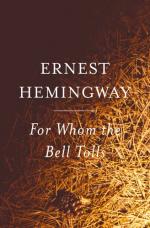|
|
For Whom the Bell Tolls Author/Context
Ernest Hemingway was born in Oak Park, Illinois, in 1899. Growing up, he was very close to his father, Dr. Clarence Edmonds (Ed) Hemingway, who taught him to shoot, fish, and camp as a boy. Ed was also a strict father, with harsh discipline who often argued with his wife, Grace. In 1928, Ed killed himself with his father's revolver from the Civil War.
Although Ernest Hemingway's problems in his relationship with his mother had started during his adolescence, after his father's suicide, his estrangement from his mother became worse. He believed in male supremacy, and the heroines of his books are submissive and serve their men. He had four wives, Hadley Richardson (m.1921-1927), Pauline Pfeiffer, (m.1927-1940), Martha Gellhorn (m.1940-1946), and Mary Welch (m. 1946-1961), usually marrying one a short time after divorcing another.
He wrote for his school paper and wrote short stories in high school, often with himself as the hero, and he got his first writing job at the Kansas City Star in 1917. There he learned much of what influenced his later works. He learned to write like a journalist; his style is very readable, objective, clear, and avoids a great deal of description.
In 1918, he was called to the war to drive an ambulance for the American Red Cross in Italy. There he was severely wounded in both legs, but saved another man's life, and was awarded a medal of honor from the Italian army. This experience rid him of any romantic notions of war, for he became an insomniac and thought often of death.
In 1921, Hemingway and his first wife Hadley Richardson moved to Paris. Hemingway loved Paris, and quickly made friends with expatriates such as the famous authors James Joyce, F. Scott Fitzgerald, Gertrude Stein, and Ezra Pound. These expatriates are the models for one of his earliest novels, The Sun Also Rises (1926), which features not very complimentary or well-disguised portraits of many of his friends and acquaintances.
Hemingway had spent extensive time in Spain during the 1920's, and was especially interested in the annual festival of San Fermin in Pamplona in mid-summer, where the running of the bulls takes place. It is here that he was introduced to the Spanish tradition of bullfighting. He was entranced with the people and the culture, and especially obsessed with bullfighting, about which he wrote Death in the Afternoon (1932). In 1937, Hemingway was sent to Spain to write about the Spanish Civil War for the North American Newspaper Alliance. The war had broken out in 1936, as large landowners, military, the church, and monarchists, supported by German and Italian fascist forces, revolted to overthrow the Republican, pro-democracy government which had replaced the monarchy in 1931. Hemingway sided with the Republicans, and his sympathy for them is obvious in For Whom The Bell Tolls, in which he glorifies three intense and often tragic days in the life of a group of Republican guerrilla fighters.
His novel The Old Man and the Sea (1952) met with wide acclaim, and he won the Nobel prize in 1954. However, in the last years of his life, he was unable to write a novel that met with comparable success. He felt barren and alone, and sunk into deep depression and heavy drinking. In 1961, he killed himself in Ketchum, Idaho. Several of his manuscripts for novels have been published posthumously, including A Moveable Feast and Islands in the Stream. His distinctive style was considered the most influential aspect of his writing, and he had an enormous stylistic influence on American literature. Samuel Shaw writes in his biography of Hemingway: "The positive, humanistic core of his fiction-tentative, held in check by his toughness and his style-has not been fully explored or appreciated... In an age of spiritual decay and defeat, presenting honestly the condition of that age, he yet upheld the goodness, nobility, and spiritual worth of mankind."
Bibliography
Castillo-Puche, José Luis. Hemingway in Spain: An intimate look at the importance of Spain in the life and work of a great artist. Garden City: Doubleday and Co., 1973
Hemingway, Ernest. For Whom the Bell Tolls. New York: Macmillan Publishing Company, 1987
Lynn, Kenneth S. Hemingway. New York: Simon and Schuster, 1987.
Shaw, Samuel. Ernest Hemingway. New York: Frederick Ungar Publishing Company, 1973.




